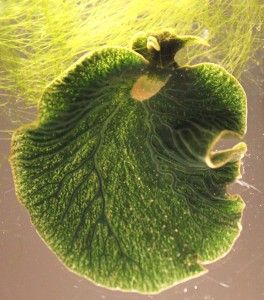There are times when I ask myself why I chose a career in science. This happens on what I call “grass is greener” days. On these days I dream of other careers—like National Geographic reporter or Caribbean tour guide–which all sound way more exciting than scientist. Admittedly these alternative careers are not ones that many people have the privilege of attaining, but sometimes reality gets to take a vacation. Fortunately, science is a fast-moving, always-changing field. As much as I might occasionally dream of exotic jobs in far away locations, science always pulls me back in with something new and unexpected. Because as much as we’d like to think we know, the truth is there is so much more that we don’t.
A case in point—sea slugs. These unfortunately named, exotic looking creatures have some surprising secrets.
Continue reading “Animal or Plant? FISH Labeling Reveals Horizontal Transfer of Algae Gene into Sea Slug Chromosome”
 Stainless steel is often used in clinical and public settings as work surfaces as well as other surfaces that are touched and cleaned often. Stainless steel is used in these applications for many of the same reasons I like it for jewelry: it is strong, resilient, relatively inexpensive, stain- and corrosion-resistant and will weather regular cleaning/exposure to moisture well. There is something about a gleaming stainless steel work surface that looks, well, sterile. But is it?
Stainless steel is often used in clinical and public settings as work surfaces as well as other surfaces that are touched and cleaned often. Stainless steel is used in these applications for many of the same reasons I like it for jewelry: it is strong, resilient, relatively inexpensive, stain- and corrosion-resistant and will weather regular cleaning/exposure to moisture well. There is something about a gleaming stainless steel work surface that looks, well, sterile. But is it? 